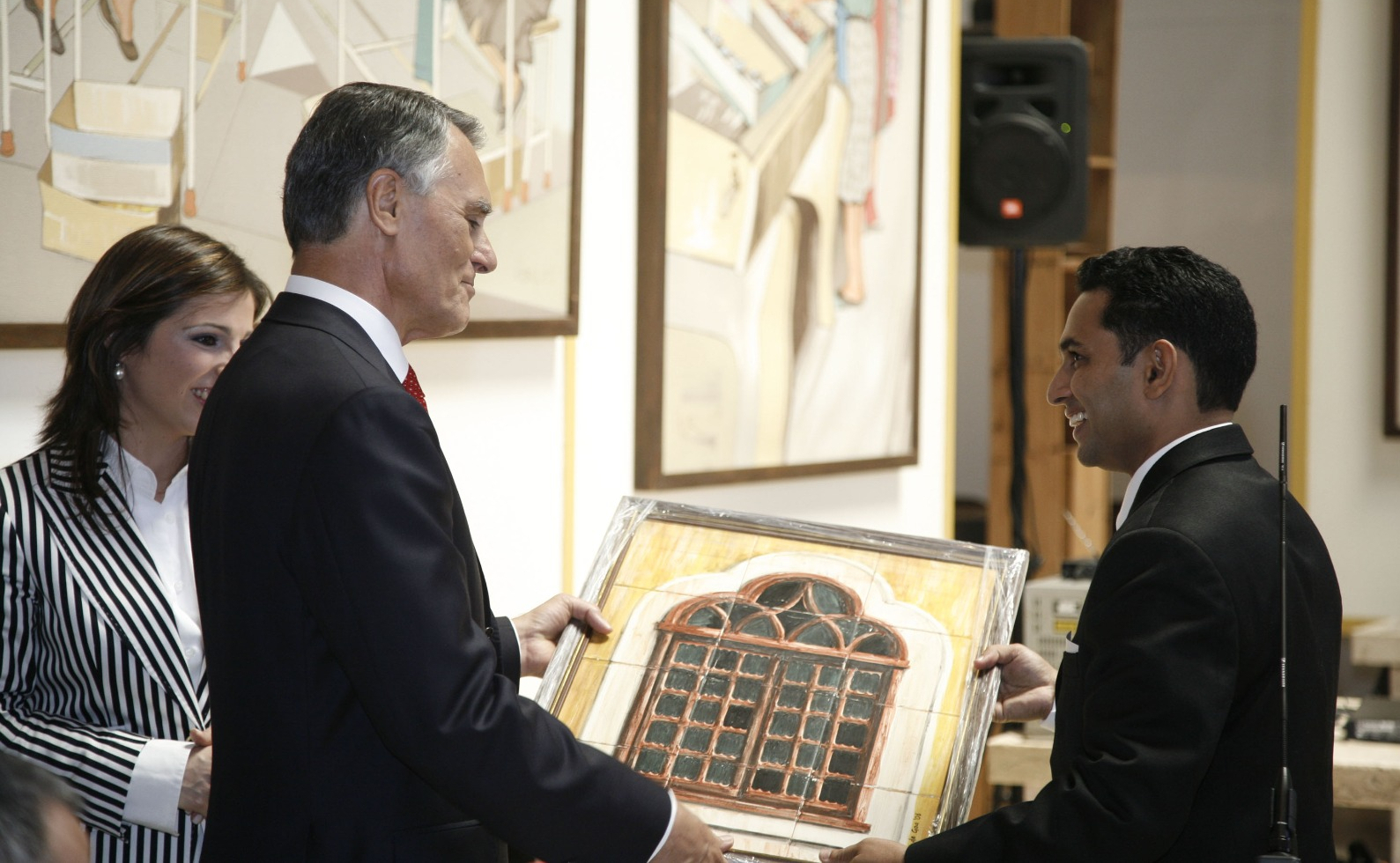Captivating white and blue Portuguese hand-painted ceramic tiles are popular in Goa

U.S. Ambassador to India Eric Garcetti appreciating the intricate art of painting Azulejos at the Azulejos de Goa gallery in Panaji-Goa in October 2023.
CALIFORNIA
When U.S. Ambassador to India, Eric Garcetti, visited Goa in October 2023, one of the visits on his itinerary included the Azulejos de Goa gallery in Panaji.
He was so impressed with the Azulejos that he posted his appreciation on his social media ‘X’ account: “I had a wonderful time at Azulejos de Goa, learning about the gallery’s efforts to revive and introduce the locally designed azulejos. These gorgeous traditional hand-painted ceramic tiles are more than art adorning Goan homes, they really reflect the region’s unique heritage.”
Azulejos, which the Portuguese introduced in Goa, have now become popular in the State, especially as mementoes, curios, nameplates on houses or paintings on walls – not unlike in Portugal.
In fact, strolling the streets of Portugal, it’s impossible to miss the Azulejos, the striking white and blue ceramic tiles, which are more than just decorative tiles. They represent a rich tapestry of Portuguese heritage and craftsmanship and are as synonymous with Portugal as Fado and Bacalhau codfish.
The fusion of diverse influences – Islamic, Moorish, Spanish, and Dutch – gave rise to the unique style of Portuguese Azulejos, a testament to the cultural exchange and artistic cross-pollination during Portugal's golden age of exploration.
ORIGINS OF AZULEJOS
The tiles, called Azulejos (from the Arabic word 'al zuleique', which means “little polished stone”) were originally brought to Europe by invading Moors in the 13th century. Portuguese azulejo tiles are heavily influenced by ‘arabesque’. This style employs flowing lines, stars, flowers, foliage, fruits and sometimes animal and figural outlines to produce an intricate pattern of interlaced lines that can be tiled in endless combinations.
Arabic calligraphy also found its way into Portuguese tile design, with verses from the Quran or poetic texts inscribed on the tiles. These inscriptions added a spiritual and intellectual dimension to their visual appeal. The delicate balance between mathematical precision and aesthetic beauty became a hallmark of Islamic-inspired Azulejos.
From intricate patterns to elaborate narratives, Portuguese tiles are a testament to the skill and creativity of the artisans who crafted them, and they continue to be treasured and celebrated to this day. They have been widely used to embellish both public and private buildings, churches, palaces, and even humble homes.
 Goan artist Orlando de Noronha presenting a Goan Window hand-painted on Azulejos to then President of Portugal, Professor Aníbal Cavaco Silva, at a special function at the Museu do Trabalho, Setúbal, Portugal, on June 9, 2007. On the left is the Portuguese Fado singer Kátia Guerreiro.
Goan artist Orlando de Noronha presenting a Goan Window hand-painted on Azulejos to then President of Portugal, Professor Aníbal Cavaco Silva, at a special function at the Museu do Trabalho, Setúbal, Portugal, on June 9, 2007. On the left is the Portuguese Fado singer Kátia Guerreiro.
Integrating Azulejos into architectural design has not only added beauty and elegance but also served practical purposes such as insulation and protection against the elements.
AZULEJOS IN PORTUGAL
The first use of Azulejos in Portugal can be traced back to the late 15th century when King Manuel visited Seville in Spain and was enthralled by the shiny tiles around the city. He decided to bring this showy art to Portugal and used it to decorate the walls of his castle: the Sintra National Palace.
By the 16th century, Portugal was importing Azulejos from Spain, particularly those from the region of Seville. The Spanish introduced tin-glazed tiles, known as "azulejos de cuerda seca," which involved applying tin oxide over the glaze to create a white background. This technique allowed for vibrant cobalt blue pigments to stand out, resulting in a striking visual contrast.
Early Portuguese Azulejos were often adorned with blue, yellow, green, and white colours. However, during the 16th century, blue and white tiles became most prevalent because European artists were enraptured with Chinese porcelain. However, the ingredients to make this porcelain did not exist in Europe, making Chinese porcelain a rarity.
In the 17th century, the Dutch began copying this style. The Portuguese loved this affordable option and ordered tiles from the Dutch to decorate buildings. The Dutch, known for their mastery of ceramic arts, also left their mark on Portuguese tiles. Dutch tile painters introduced narrative elements, depicting scenes from mythology, history, and daily life. These storytelling tiles often portrayed intricate details and conveyed a sense of movement and drama.
The Dutch influence encouraged Portuguese artists to explore new subjects and experiment with depicting complex narratives within the limited space of the tiles. The Portuguese, later on, began manufacturing their own in white and blue at a large scale.
The “Ciclo dos Mestres” (the cycle of masters) hired renowned painters to design works in this format and begin to manufacture on a large scale, thus tile painters finally gained the status of “artists” by creating original pieces and signing their works.
The 17th century in Portugal was by far the century of patterns, more than 1,000 patterns have been meticulously documented and they are still discovering new patterns from that era. [To be continued]
[The writer is an engineer retired in Silicon Valley. His interests include blogging, gardening, nature photography and travelling]